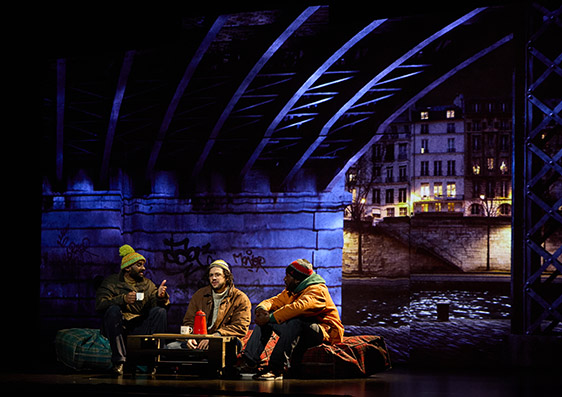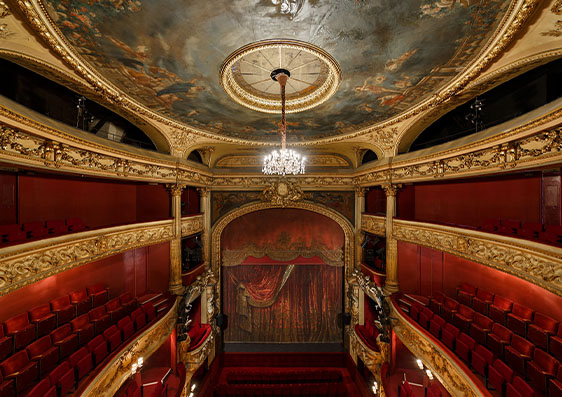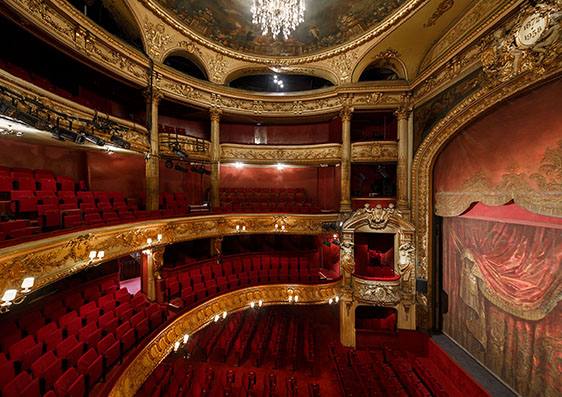Passeport

Location
20 boulevard Saint-Martin, 75010 Paris
Capacity 618 seats
Duration
1 h 30 min
No intermission
Details
Classic Theatre
For all audiences
In French with English surtitles
THIS SHOW IS IN FRENCH WITH ENGLISH SURTITLES!
HIGHLIGHTS: PASSEPORT
Reviews
Théâtre de la Renaissance
History and Fun Facts about Théâtre de la Renaissance
There are theatres in Paris where you feel like you're playing a full part in cultural life, and there is perhaps no greater example of such a theatre than the Théâtre de la Renaissance.
Located on the majestic Grands Boulevards, the Théâtre de la Renaissance has stood proudly since 1873. This little Italian-style architectural gem, the work of Charles Delalande, assistant to Charles Garnier (architect of the Opéra Palais Garnier), has had a rich and eventful history, punctuated by dazzling successes and periods of darkness. The theatre makes an impression with its elegant, highly refined architecture. The horseshoe-shaped auditorium can seat up to 628 spectators. The ceiling, painted by Georges Clairin, depicts The Apotheosis of Poetry. The stage is deep and well-equipped for spectacular productions.
Founded in 1838 by Anténor Joly, on the initiative of Victor Hugo and Alexandre Dumas, the Théâtre de la Renaissance quickly established itself as a Mecca of Romanticism. Iconic plays such as Hugo's Ruy Blas and Dumas's Don César de Bazan were staged there, attracting enthusiastic audiences.
Over the decades, the Théâtre de la Renaissance experienced both good times and bad. Burnt down during the Paris Commune in 1871, it was rebuilt and reopened in 1873. The theatre then enjoyed another joyous period of success, playing operas such as Bizet's Carmen and Delibes' Lakmé.
The famous French actress Sarah Bernhardt, who wanted to be free to choose her roles, took the reins of the theatre from 1893 to 1899. Under her direction the theatre produced Gismonda by Victorien Sardou and Izeyl by Eugène Morand and Armand Silvestre, with incidental music by Gabriel Pierné, in 1894, La Princesse lointaine by Edmond Rostand in 1895, Les Amants by Maurice Donnay and La Figurante by François de Curel in 1896, La Ville morte by Gabriele D'Annunzio, L'Affranchie by Maurice Donnay, Le Radeau de La Méduse by Romain Coolus in 1898. On 3 December 1896, she herself took on the title role in Lorenzaccio by Alfred de Musset, followed by La Samaritaine by Edmond Rostand.
Upheaval marked the twentieth century at the theatre. The First World War and the Second World War led to temporary closures and a drop in attendance. The theatre also faced growing competition from cinema and television. Since the 1990s, the Théâtre de la Renaissance has undergone a transformative revival. Listed as a historic monument in 1994, it underwent a major renovation and its programme has expanded to include classical and contemporary plays and masterful musical performances.
Today, the Théâtre de la Renaissance is a key venue in the cultural life of Paris. Every year, it hosts a rich and varied programme of shows, always aimed at a diverse audience. The theatre is resolutely in tune with the times, but has maintained the legacy of its architectural and historical heritage. Come and discover this remarkable place and its unique architecture while taking in a spectacular programme.
Fast Facts
Capacity: 618
Handicap accessible: No
Air conditioning: Yes
Heating: Yes
Coat check: Yes (paid service)
FAQ
How do I get to Théatre de la Renaissance in the 16th arrondissement of Paris?
The Théatre de la Renaissance is accessible by:
Metro: Line 4, 8 and 9 (station Strasbourg Saint-Denis)
Address: 20 boulevard Saint-Martin, 75010 Paris
In case of difficulty, our hotline can be reached during our business hours. Please see the footer of this page for our contact details.
What do I do when I get to Théatre de la Renaissance?
As part of the Vigipirate Plan, we would like to inform you that personal belongings will be systematically checked. We therefore ask you to arrive at Théatre de la Renaissance as early as possible to avoid any inconvenience caused by late arrival and the checking of your items.
Access to the Théatre de la Renaissance may be refused to anyone arriving with luggage, bulky accessories, or electric bicycle batteries.
We recommend that you arrive at least 30 minutes before the start of your show. Show your ticket at reception and the staff of Théatre de la Renaissance will take care of you.
Please note that for 8:00 p.m. shows, doors close at 7:55 p.m. and for 3:00 p.m. shows, doors close at 2:55 p.m.
How long does Passeport, last?
Passeport at Théatre de la Renaissance lasts approximately 1 hour and 30 minutes, with no intermission.
Is Passeport for an international audience or French speakers?
Both! The Théatre de la Renaissance has been welcoming audiences from all over the world for many years. The opera, Passeport, is sung in its original French version with surtitles in both French and English. Thanks to the innovative minds at Panthea and Theatre in Paris, the surtitles will be shown via smartglasses (Augmented Reality glasses) so that international audiences can appreciate this incredible piece!
What are smartglasses and how will I be able to see the surtitles*?
The show Passeport at Théatre de la Renaissance has partnered with Theatre in Paris and Panthea, to provide smartglasses for surtitling… An exciting innovation!
How do smartglasses for surtitling work? These smartglasses include a new technology developed by Panthea that enables surtitles to be shown in an individual spectator’s view, within the glasses, during a live performance. In addition to the surtitles, these Augmented Reality glasses can also be connected to a headset for Audio Description as well as display a video with sign language depending on the show. These features not only make performances accessible to a wider audience but also allow for audience members to have a personalized experience in a way that suits them best.
The opera Passeport will be performed in French with surtitles provided in English via smartglasses.
*Surtitles (also called supertitles) are the theatre equivalent of subtitles. That’s because in French “sur” means “above”.
Is there a dress code at Théâtre de la Renaissance?
There is no specific dress code at Théâtre de la Renaissance, but proper attire is appreciated. Many Parisians will arrive directly from work, dressed in business casual or chic attire.













